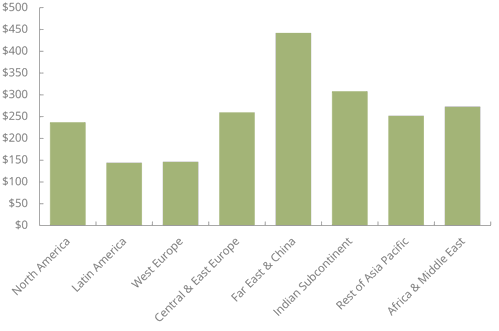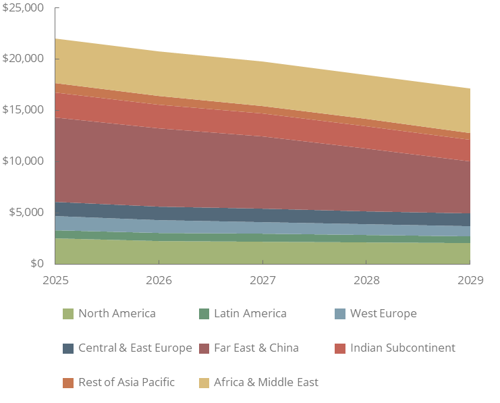What Google Dropping SMS OTPs Means for Mobile Identity
Google has just shaken up its Gmail login process by announcing the removal of SMS one-time passwords (OTPs), replacing them with QR codes for identity verification. Given growing concerns over the security and cost of SMS OTPs, the move makes sense — but the switch to QR codes caught many off guard.
It’s worth noting that this update won’t affect everyone. Many users already rely on more secure options like passkeys or the Google Authenticator app, and they’ll continue to do so. The change primarily targets those still using SMS OTPs, which have long been criticised for their vulnerability to phishing and interception.
So, why now — and why QR codes?
Why Switch Now?
SMS OTPs have experienced high levels of fraudulent activity recently, impacting all stakeholders in the value chain, including mobile subscribers, enterprises and mobile operators. Fraudulent activity such as artificially inflated traffic (AIT) and SMS trashing attempts have led to diminishing trust in SMS as an authentication method; leaving stakeholders to seek alternative methods to verify their users. AIT and SMS trashing occurs when fraudulent players generate many fake accounts on a legitimate enterprise’s website, prompting two-factor authentication and thus a significant number of OTPs to be sent via SMS.
Additionally, the cost of A2P SMS has risen considerably in the last couple of years, with A2P SMS costs almost doubling in some regions. This has made authentication particularly costly for enterprises, with the combination of these increased costs and high levels of fraudulent activity intensifying the need for new forms of mobile identity.
Total Cost of AIT and SMS Trashing to Enterprises ($m) in 2024

Source: Juniper Research
Google’s decision, therefore, to replace SMS OTPs in their Gmail authentication processes is not a surprise, despite the dominance of SMS OTPs within mobile identity, and we anticipate that many enterprises and organisations will follow in this development.
Are QR Codes the Answer?
While Google’s switch from SMS OTPs for Gmail was an entirely expected move, the announcement that QR codes would be the new method to authenticate a user was less anticipated. QR codes have numerous benefits, including enhanced security through the requirement for the user to be present to scan the QR code, as well as removing the need for users to memorise often complex passwords. Furthermore, QR codes enable quick authentication and require little infrastructure from the enterprise; making them cost-effective. These benefits make them a viable alternative to the previously dominant SMS OTPs.
However, there are limitations when considering QR codes for mobile identity. The use of QR codes assumes a level of technology that not all users may have, as it depends on the user having a smartphone or device with camera and scanning capabilities. Also, it presumes that most users will be accessing their Gmail account on an alternative device from the one that is being used to scan the QR code, which with the demand for access to accounts on the go is unlikely. Therefore, the use of QR codes for mobility identity by Google risks alienating some users.
This switch exemplifies a wider market dynamic, with the issues surrounding SMS OTPs also prompting other organisations to follow a similar trend to Google. The consequence of this will be felt most significantly by mobile operators, who (as per our recent forecasts) received $22.3 billion in SMS OTP revenue globally in 2024. Stakeholders moving away from SMS OTPs as a mobile identity solution to non-operator billed methods provides a substantial threat to future mobile operator revenue streams.
Total Operator-billed Revenue from SMS OTPs ($m), Split by 8 Key Regions, 2025-2029

Source: Juniper Research
So, What's the Future of Mobile Identity?
Given Google’s significant investment and role in the development of rich communication services (RCS), Juniper Research was surprised that Google had opted for QR codes for Gmail authentication. Similar to SMS, RCS can be used for OTPs in authentication, and with Google’s involvement in the development of RCS, it would have seemed a natural progression to implement RCS OTPs into Gmail authentication methods.
RCS offers numerous advantages for mobile identity when compared to SMS, with RCS providing enhanced security through verified sender profiles and branded messaging capabilities. However, the lack of established reach with RCS proves to be a complexity in utilising it for mobile identity, with many mobile operators not yet supporting the messaging platform.
RCS has capabilities extending further than OTPs, with it enabling richer communications between enterprises and customers such as two-way conversations and enhanced graphics and images. Therefore, the developmental and commercial focuses for RCS were centred around marketing and conversational use cases, rather than OTPs.
Additionally, over the top (OTT) messaging platforms such as WhatsApp have a wide reach and are already utilised by some enterprises for OTP use cases, however with this service being provided by one of Google’s rivals, Meta, it explains why Google have not opted for this service for authentication.
In summary, Google’s decision to move away from SMS OTPs responds to the concerns surrounding SMS as an authentication channel, but there is yet to be a clear successor within mobile identity; with a range of options being explored by enterprises. In turn, Juniper Research’s recent mobile identity study predicted that application programming interfaces (APIs) which authenticate users silently in the background of the device, by utilising the mobile network, will replace SMS as the dominant form of mobile identity. This owes to the high level of security that silent authentication APIs offer and the user friendliness provided with a lack of user interaction.
Georgia is a Research Analyst in Juniper Research’s Telecoms & Connectivity team, providing analysis on the emerging trends and latest developments in the telecommunications market. Her recent reports include Mobile Identity, AIT Prevention, and Robocall Mitigation & Branded Calling.
Latest research, whitepapers & press releases
-
 ReportDecember 2025
ReportDecember 2025AI Agents for Customer Experience Platforms Market: 2025-2030
Our comprehensive AI Agents for Customer Experience Platforms research suite comprises detailed assessment of a market that is set to disrupt mobile communications. It provides stakeholders with insight into the key opportunities within the AI agents for customer experience platforms market over the next two years.
VIEW -
 ReportDecember 2025Fintech & Payments
ReportDecember 2025Fintech & PaymentseCommerce Fraud Prevention Market: 2025-2030
Our eCommerce Fraud Prevention research suite provides a detailed and insightful analysis of this evolving market; enabling stakeholders from financial institutions, law enforcement agencies, regulatory bodies and technology vendors to understand future growth, key trends, and the competitive environment.
VIEW -
 ReportNovember 2025Telecoms & Connectivity
ReportNovember 2025Telecoms & ConnectivityeSIMs & iSIMs Market: 2025-2030
Juniper Research’s eSIMs and iSIMs research suite offers insightful analysis of a market set to experience significant growth in the next five years. The research suite provides mobile network operators (MNOs), original equipment manufacturers (OEMs), and eSIM management and platforms vendors with intelligence on how to capitalise on the market growth, and guidance on how eSIM-only devices and sensors, SGP.42, in-factory provisioning, and iSIMs will change the competitive landscape.
VIEW -
 ReportNovember 2025Fintech & Payments
ReportNovember 2025Fintech & PaymentsModern Card Issuing Platforms Market: 2025-2030
Our Modern Card Issuing Platforms Market research suite provides a detailed and insightful analysis of this evolving market; enabling stakeholders from banks, financial institutions, fintech companies, and technology vendors to understand future growth, key trends, and the competitive environment.
VIEW -
 ReportNovember 2025Fintech & Payments
ReportNovember 2025Fintech & PaymentsDigital Wallets Market: 2025-2030
Our digital wallets research suite provides detailed analysis of this rapidly changing market; allowing digital wallet providers to gain an understanding of key payment trends and challenges, potential growth opportunities, and the competitive environment.
VIEW -
 ReportOctober 2025Fintech & Payments
ReportOctober 2025Fintech & PaymentsDigital Identity Market: 2025-2030
Juniper Research’s Digital Identity research suite provides a comprehensive and insightful analysis of this market; enabling stakeholders, including digital identity platform providers, digital identity verification providers, government agencies, banks, and many others, to understand future growth, key trends, and the competitive environment.
VIEW
-
 WhitepaperDecember 2025Telecoms & Connectivity
WhitepaperDecember 2025Telecoms & ConnectivityHuman + AI: Drivers of Customer Experience AI Agents in 2026
Our complimentary whitepaper, Human + AI: Drivers of Customer Experience AI Agents in 2026, examines the key drivers of the AI agents for customer experience platforms market in 2025.
VIEW -
 WhitepaperDecember 2025Fintech & Payments
WhitepaperDecember 2025Fintech & PaymentsBeyond Chargebacks: The True Cost of Fraud for Digital Commerce
Our complimentary whitepaper, Beyond Chargebacks: The True Cost of Fraud for Digital Commerce, examines the state of the eCommerce fraud prevention market; considering the impact of evolving digital fraud strategies, including key trends such as identity theft, account takeovers, chargebacks, policy abuse and friendly fraud.
VIEW -
 WhitepaperNovember 2025Telecoms & Connectivity
WhitepaperNovember 2025Telecoms & ConnectivityeSIM-only Devices: The Impact on Operators, Consumers, and IoT
Our complimentary whitepaper, eSIM-only Devices: The Impact on Operators, Consumers, and IoT, explores the challenges and opportunities for the three segments, with a particular focus on eSIM-only smartphones and SGP.42.
VIEW -
 WhitepaperNovember 2025Fintech & Payments
WhitepaperNovember 2025Fintech & PaymentsUnlocking the Next Stage of Growth for Modern Card Issuing Platforms
This free whitepaper analyses key trends shaping the modern card issuing space, and the ways in which modern card issuing platforms can capture growth.
VIEW -
 WhitepaperNovember 2025Fintech & Payments
WhitepaperNovember 2025Fintech & PaymentsTop 10 Fintech & Payments Trends 2026
Fintech is evolving fast. From stablecoins to agentic AI, our annual guide reveals the shifts redefining payments, digital identity, and the future of money in 2026. Download your copy today.
VIEW -
 WhitepaperNovember 2025Fintech & Payments
WhitepaperNovember 2025Fintech & PaymentsDigital Wallets: Empowering Financial Inclusivity
Our complimentary whitepaper, Digital Wallets: Empowering Financial Inclusivity, examines the state of the digital wallets market; considering the impact of digital wallets on different geographies, how they are shaping the modern payments landscape through lower transaction fees and promoting financial inclusivity for underbanked populations, and how they are competing with established payment methods.
VIEW
-
Telecoms & Connectivity
Travel eSIM Margins Under Pressure as Revenue per Gigabyte Falls 10% Globally in Two Years
December 2025 -
Telecoms & Connectivity
AI Agents to Power 1,000% More Customer Interactions for Enterprises Globally by 2027
December 2025 -
IoT & Emerging Technology
Global D2C Revenue Set for $370 Million Surge, But Satellite Operators Should Not Chase Full MNO Status
December 2025 -
Fintech & Payments
Digital Goods Fraud to Cost eCommerce Merchants $27 Billion Globally by 2030 as AI Tools Accelerate Attacks
December 2025 -
Fintech & Payments
AML Adoption to Hit 3.8 Million Businesses Globally by 2030, With Europe at the Forefront
November 2025 -
Telecoms & Connectivity
eSIM Connections to Grow 300% Globally in Next 5 Years, as China Presents Instant Opportunities
November 2025























